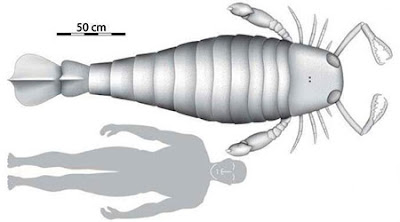 British and German researchers reported Wednesday they had discovered the giant fossilised claw of an ancient sea scorpion that, in its heyday hundreds of millions of years ago, would have been some 2.5 metres (8.1 feet) long.
British and German researchers reported Wednesday they had discovered the giant fossilised claw of an ancient sea scorpion that, in its heyday hundreds of millions of years ago, would have been some 2.5 metres (8.1 feet) long.The find, in a quarry near the western German border town of Pruem, is the biggest specimen of arthropod ever found.
 The 46-centimetre (18.4-inch) claw was wielded by a species of sea scorpion called Jaekelopterus rhenaniae that lived between 460 and 255 million years ago.
The 46-centimetre (18.4-inch) claw was wielded by a species of sea scorpion called Jaekelopterus rhenaniae that lived between 460 and 255 million years ago.Using the claw as a benchmark, the scientists believe its owner was between 2.33 and 2.59 metres (7.57 and 8.41 feet) long.
Chelicerae -- wand-like appendages used to grasp food and bring it to the beast's mandibles -- would have added another half-metre (1.6 feet).
Despite their name, sea scorpions, known as eurypterids, were not true scorpions. Equipped with long, flat, jointed carapaces, they stalked warm shallow sea waters from around 500 million to 250 million years ago, eventually moving into in fresh water.
Source: Afp
Tags: Scorpion | Arthropod | Jaekelopterus Rhenaniae | Fossil | Claw
Comments